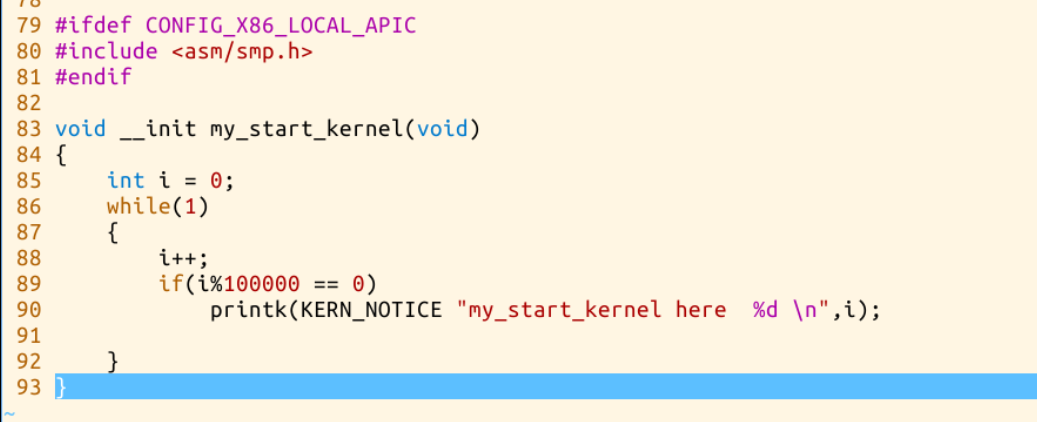2020-2021-1 20209306 《linux内核原理与分析》第三周作业
一、实验:完成一个简单的时间片轮转多道程序内核代码
在LinuxKernel/linux-3.9.4目录下查看mymain.c和myinterrupt.c的代码,为了完成实验,需将其中代码进行相应修改。
未修改mymain.c中的代码:

未修改的myinterrupt.c代码:

通过对教材的理解和GitHub上代码的查看,对两个文件进行相应的代码修改。
对mymain.c进行相应的修改,这里是mykernel内核代码的入口,负责初始化内核的各个组成部分。以下为相应修改后的代码:
#include <linux/string.h>
#include <linux/ctype.h>
#include <linux/tty.h>
#include <linux/vmalloc.h>
#include "mypcb.h"
tPCB task[MAX_TASK_NUM];
tPCB * my_current_task = NULL;
volatile int my_need_sched = 0;
void my_process(void);
void __init my_start_kernel(void)
{
int pid = 0;
int i;
/* Initialize process 0*/
task[pid].pid = pid;
task[pid].state = 0;/* -1 unrunnable, 0 runnable, >0 stopped */
task[pid].task_entry = task[pid].thread.ip = (unsigned long)my_process;
task[pid].thread.sp = (unsigned long)&task[pid].stack[KERNEL_STACK_SIZE-1];
task[pid].next = &task[pid];
/*fork more process */
for(i=1;i<MAX_TASK_NUM;i++)
{
memcpy(&task[i],&task[0],sizeof(tPCB));
task[i].pid = i;
task[i].thread.sp = (unsigned long)(&task[i].stack[KERNEL_STACK_SIZE-1]);
task[i].next = task[i-1].next;
task[i-1].next = &task[i];
}
/* start process 0 by task[0] */
pid = 0;
my_current_task = &task[pid];
asm volatile(
"movl %1,%%rsp\n\t" /* set task[pid].thread.sp to rsp */
"pushl %1\n\t" /* push rbp */
"pushl %0\n\t" /* push task[pid].thread.ip */
"ret\n\t" /* pop task[pid].thread.ip to rip */
:
: "c" (task[pid].thread.ip),"d" (task[pid].thread.sp) /* input c or d mean %ecx/%edx*/
);
}
int i = 0;
void my_process(void)
{
while(1)
{
i++;
if(i%10000000 == 0)
{
printk(KERN_NOTICE "this is process %d -\n",my_current_task->pid);
if(my_need_sched == 1)
{
my_need_sched = 0;
my_schedule();
}
printk(KERN_NOTICE "this is process %d +\n",my_current_task->pid);
}
}
}
接下来修改myinterrupt.c,主要是增加了进程切换的代码my_schedule(void)函数。修改后代码如下:
#include <linux/string.h>
#include <linux/ctype.h>
#include <linux/tty.h>
#include <linux/vmalloc.h>
#include "mypcb.h"
extern tPCB task[MAX_TASK_NUM];
extern tPCB * my_current_task;
extern volatile int my_need_sched;
volatile int time_count = 0;
/*
* Called by timer interrupt.
* it runs in the name of current running process,
* so it use kernel stack of current running process
*/
void my_timer_handler(void)
{
if(time_count%1000 == 0 && my_need_sched != 1)
{
printk(KERN_NOTICE ">>>my_timer_handler here<<<\n");
my_need_sched = 1;
}
time_count ++ ;
return;
}
void my_schedule(void)
{
tPCB * next;
tPCB * prev;
if(my_current_task == NULL
|| my_current_task->next == NULL)
{
return;
}
printk(KERN_NOTICE ">>>my_schedule<<<\n");
/* schedule */
next = my_current_task->next;
prev = my_current_task;
if(next->state == 0)/* -1 unrunnable, 0 runnable, >0 stopped */
{
my_current_task = next;
printk(KERN_NOTICE ">>>switch %d to %d<<<\n",prev->pid,next->pid);
/* switch to next process */
asm volatile(
"pushl %%rbp\n\t" /* save rbp of prev */
"movl %%rsp,%0\n\t" /* save rsp of prev */
"movl %2,%%rsp\n\t" /* restore rsp of next */
"movl $1f,%1\n\t" /* save rip of prev */
"pushl %3\n\t"
"ret\n\t" /* restore rip of next */
"1:\t" /* next process start here */
"popl %%rbp\n\t"
: "=m" (prev->thread.sp),"=m" (prev->thread.ip)
: "m" (next->thread.sp),"m" (next->thread.ip)
);
}
return;
}
然后增加一个mypch.h,用来定义进程控制块,代码如下:
#define KERNEL_STACK_SIZE 1024*2
/* CPU-specific state of this task */
struct Thread {
unsigned long ip;
unsigned long sp;
};
typedef struct PCB{
int pid;
volatile long state; /* -1 unrunnable, 0 runnable, >0 stopped */
unsigned long stack[KERNEL_STACK_SIZE];
/* CPU-specific state of this task */
struct Thread thread;
unsigned long task_entry;
struct PCB *next;
}tPCB;
void my_schedule(void);
最后make重新编译。
二、学习总结
1.堆栈相关的寄存器
ESP:堆栈指针
EBP:基址指针
2.堆栈操作
堆栈主要用到的操作是push和pop,在上一章的课程中已经熟悉。
3.其他关键寄存器
了解了CS寄存器。一般程序都至少会用到标准库,整个程序会有多个代码段。
*顺序执行:总是指向地址连续的下一套指令。
*跳转/分支:执行这样的指令时,CS:EIP的值会根据程序需要被修改。
*call:将当前CS:EIP的值压入栈顶,CS:EIP指向被调用函数的入口地址。
*ret:从栈顶弹出原来保存在这里的CS:EIP的值,放入CS:EIP中。
4.用堆栈来传递函数的参数
对32位x86CPU来讲,通过堆栈来传递参数的方法时从右到左依次压栈。
5.了解了函数如何传递返回值,堆栈还提供局部变量的空间,编译器使用堆栈的规则。
三、学习总结和遇到的问题
第二章的学习让我了解了计算机的三个法宝:存储程序计算机、函数调用堆栈机制和中断机制;学习了借助linux内核部分源代码模拟存储程序计算机工作模型及时钟中断。
思考了一个问题:为什么应用程序不能直接访问硬件而是通过操作系统?
原因是计算机运行时,内核是被信任的第三方,只有内核可以执行特权指令。这是为了方便应用程序。
最新文章
- 动态生成验证码———MVC版
- ios开发证书
- UEFI引导在GPT分区下安装win2008——抓住那只傲娇的win2008
- JS跨域解决iframe高度自适应(IE8/Firefox/Chrome适用)
- 导师互选系统 Alpha版冲刺总结
- 【风马一族_Java】9*9口诀
- html5 中常用的标签和属性
- [原创作品] javascript 实现的web分页器原理
- 数据库的优化tips
- Linux下利用fork()创建子进程并使父进程等待子进程结束
- 转 Linux下的GoldenGate的启动关闭Shell脚本(独立)
- latex_引用参考文献格式,引用多篇参考文献
- 7.02-bs4_btc
- codeforces740B
- Java全栈程序员之06:IDEA中MAVEN项目依赖及运行
- 18-09-20 关于Xlwings读写基础1
- Access restriction: The method typeNameToClass(String) from the type ObjectHandler is not accessible due to restriction on required library
- linux下设置软件使用socks5代理
- 微信公众号自动回复 node
- java导出word文件